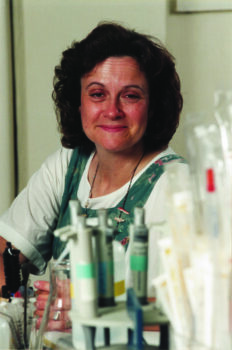Paula Lutz, who earned a bachelor’s degree in chemistry with a life science preference from UMR in 1976, and then served as a faculty member, associate dean of arts and sciences, department chair, and dean of arts and sciences, discusses adjusting to a campus which had few female faculty members.
Audio transcript

Everyone, and I think part of it was because I was a known quantity. I mean the chemists, most of the older chemists knew me from my time there and treated me well. Of course, Stig (Friberg), Nord (Gale) and Jim (Hufham) and that bunch, they treated me very well and not like . . . I guess it might have been if you come home and they kind of treat you like the kid sister or something. They treated me like a, you know, a full-fledged faculty member and bragged that they got their top choice and so they really made me feel welcome. The weird thing I do remember, Larry, in my first year, or two, or three . . . of course, we had quite a few women in biology by this time, and word spread, you know, that there were women in departments. There were starting to be a handful of women in engineering. And I would get a young woman on my doorstep that I didn’t know. And she would say, “My roommate had you for general biology and I have a question that I need to ask basically another woman.” And I’d say “Okay.” She said “What do I wear for my interview? You know, nobody is giving me any advice.” I mean these would be women with engineering experience. They were being told things that they weren’t sure were correct about how ultra conservative to be in their dress and, you know, things like that and I tried to be . . . you know, I say “well, you probably need to pay attention to what they tell you, but you probably can get away with a dress and a jacket. You don’t need to buy a suit”, right. I mean these were the kinds of things that I think women worry about and there really weren’t any women role models in the whole building. So that was, that was kind of an interesting thing. Well actually through Kappa Delta, there were a couple of other women on campus in engineering who had been Kappa Delta’s other places, and I got acquainted with them. And there were women in arts and sciences, just not so much on the science side. But I’d say women in the humanities and social sciences and the arts and sciences were very, were very welcoming to me. Liz Cummins, you know, great, just a great person. Catherine Riordon. I remember Catherine in psychology. She was very warm and welcoming. Sara Preston, actually in physical education. We crossed paths in a number of ways – children the same age, and I remember being on several committees with her. So, yeah, they were, they were very warm and welcoming, but we were a pretty select small group.
Share This Story
Spark a Memory?
Share your story! Fill out the form below to share your fondest memory or anecdote of S&T. If you'd prefer not typing, you can also share by phone at 833-646-3715 (833-Miner150).
Amanda (Gealy) and Logan Meyer
Amanda (Gealy) and Logan Meyer met through mutual friends during St. Pat’s in 2010. Amanda earned bachelor’s and master’s degrees…
Alumni leading the telecommunications industry
Roy Wilkens, EE’66, and Mario A. Padilla, MetE’60, worked for years to challenge and change the status of the telecommunications…
Robert and Mary (Shultz) Hoffmann
Robert Hoffmann knew right away when Mary (Shultz) walked into a fraternity house party with a group of four friends…
Arden Hawley and Alex Richter
Arden Hawley met Alex Richter in August 2015 after her roommate joined KMNR, where he was a DJ. “She introduced…
First impressions: UM System President Mun Choi
Mun Choi, who has served as president of the University of Missouri System since 2017...
Giving others an opportunity
Steven Frey works to ensure others have the opportunity to attend graduate programs at S&T like he did. Frey says…